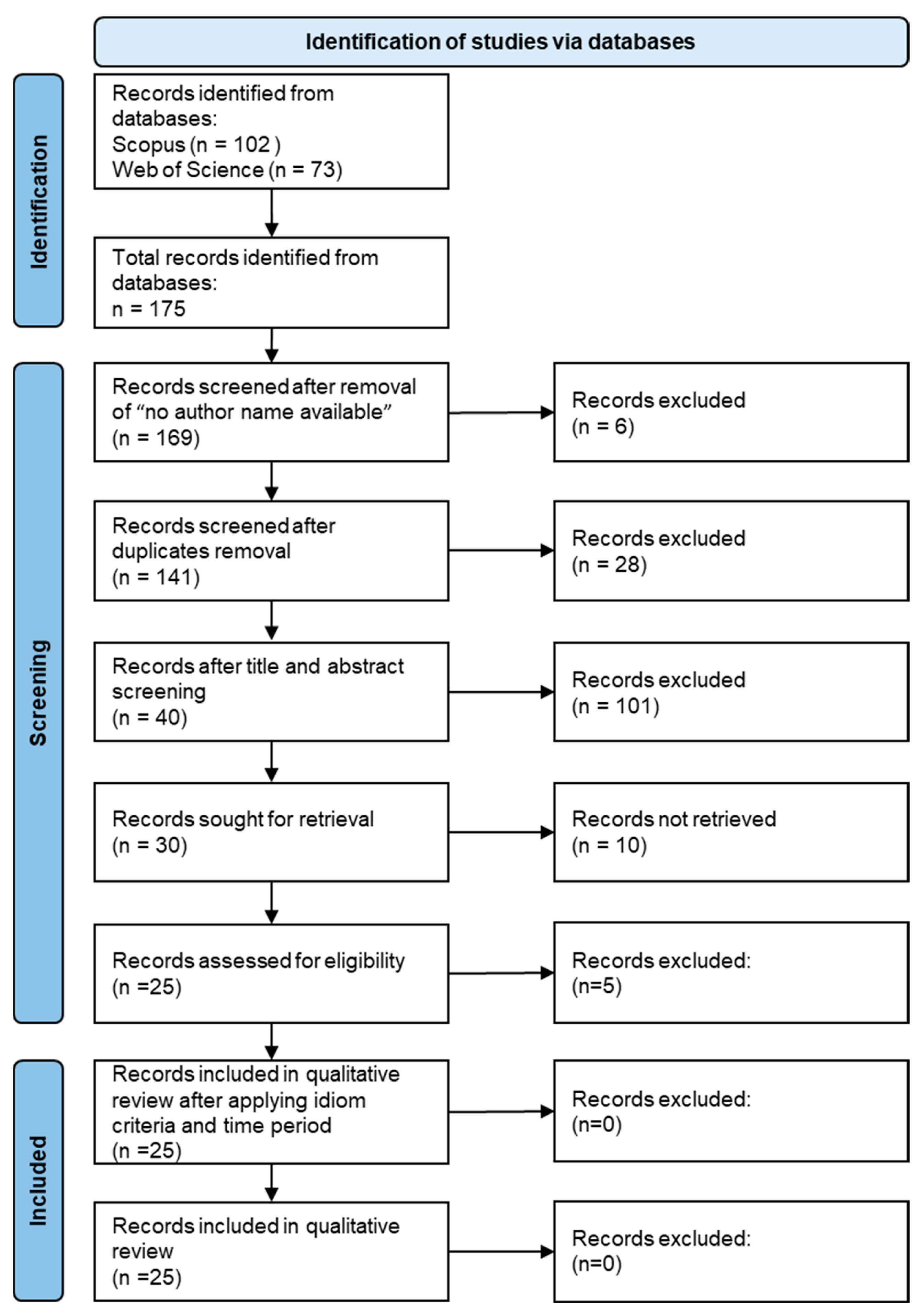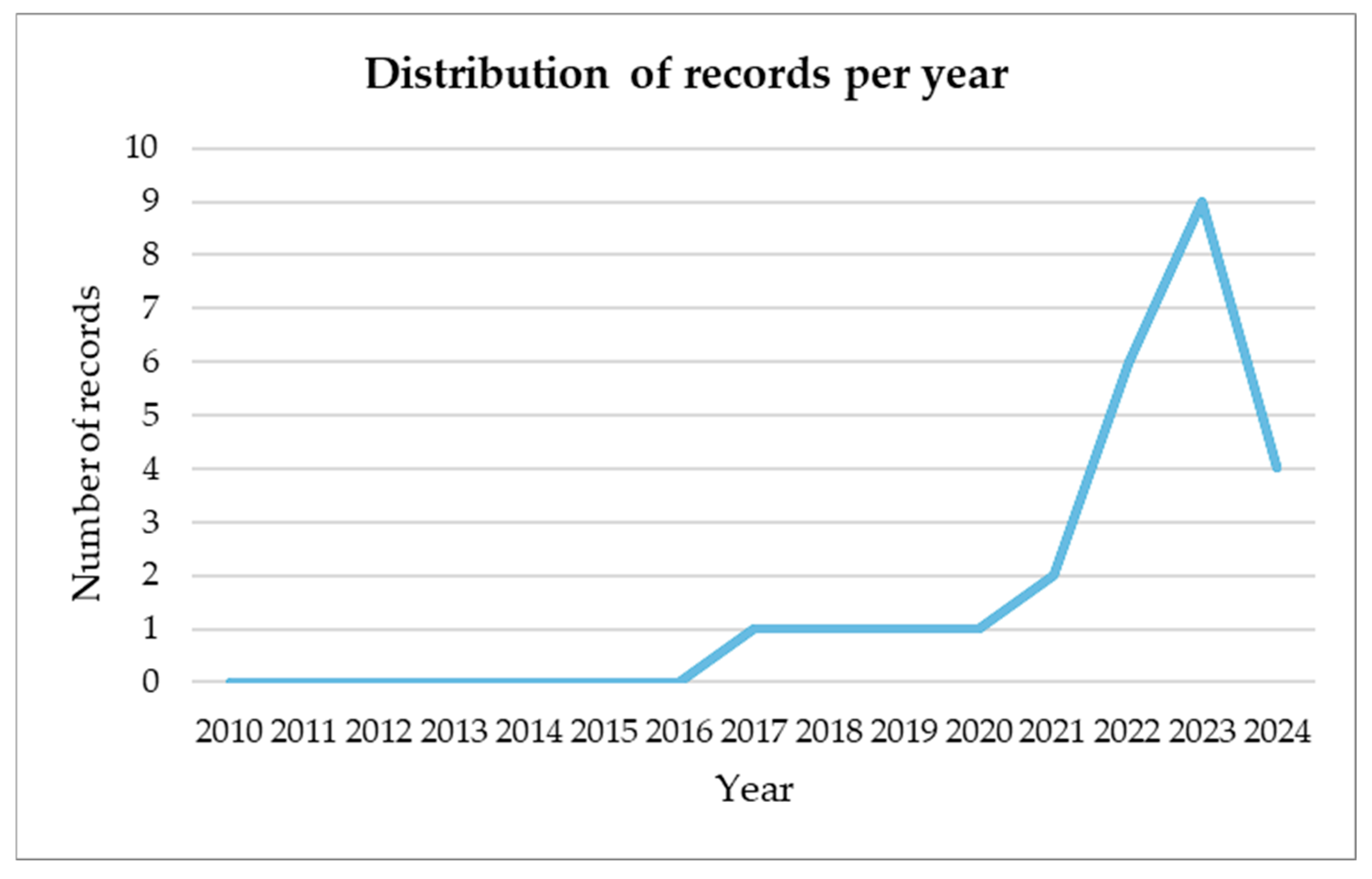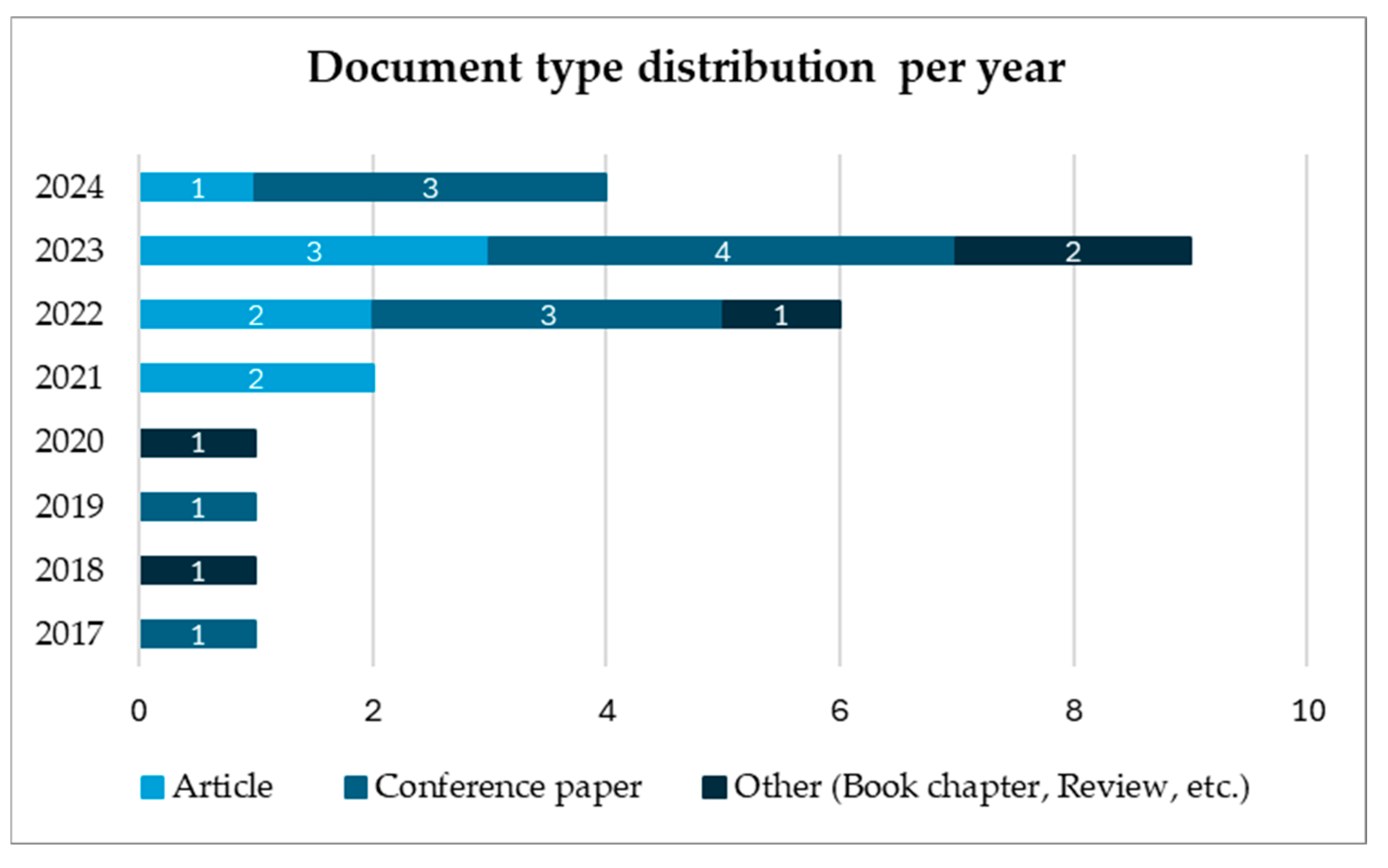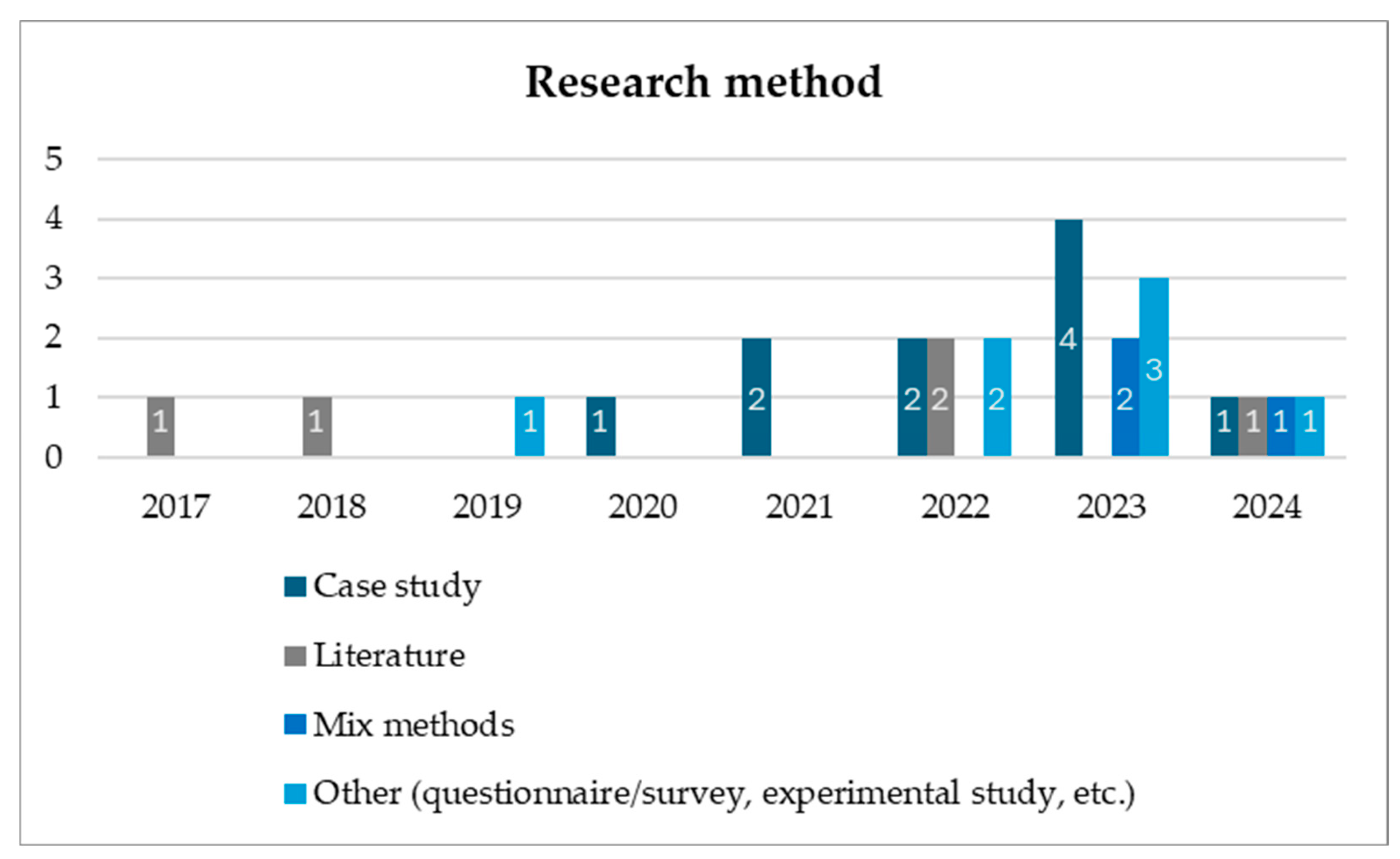The Evolution of Digital Building Logbook: Exploring Building Information Gathering Systems to Boost Building Maintenance and Renovation
Abstract
1. Introduction
2. Materials and Methods
3. Results
3.1. Bibliometric Analysis
3.2. Thematic Analysis of Selected Articles
3.2.1. Digital Building Logbook Structure and Data Categories
3.2.2. Digital Building Logbook Applications in the Building Lifecycle Phase
3.2.3. Circular Economy Promotion
3.2.4. Building Data Management
4. Discussion and Conclusions
Author Contributions
Funding
Conflicts of Interest
References
- Daniotti, B.; Bolognesi, C.M.; Spagnolo, S.L.; Pavan, A.; Signorini, M.; Ciuffreda, S.; Mirarchi, C.; Lucky, M.N.; Andersson, B.; Andersson, P.; et al. An Interoperable Bim-Based Toolkit for Efficient Renovation in Buildings. Buildings 2021, 11, 271. [Google Scholar] [CrossRef]
- Volt, J.; Toth, Z.; Glicker, J.; De Groote, M.; Borragán, G.; De Regel, S.; Dourlens-Quaranta, S.; Carbonari, G. Definition of the Digital Building Logbook-Report 1 of the Study on the Development of a European Union Framework for Buildings’ Digital Logbook; Publications Office of the European Union: Luxembourg, 2020. [Google Scholar]
- Edwards, R.E.; Lou, E.; Bataw, A.; Kamaruzzaman, S.N.; Johnson, C. Sustainability-Led Design: Feasibility of Incorporating Whole-Life Cycle Energy Assessment into BIM for Refurbishment Projects. J. Build. Eng. 2019, 24, 100697. [Google Scholar] [CrossRef]
- Lasarte, N.; Elguezabal, P.; Sagarna, M.; Leon, I.; Otaduy, J.P. Challenges for Digitalisation in Building Renovation to Enhance the Efficiency of the Process: A Spanish Case Study. Sustainability 2021, 13, 2139. [Google Scholar] [CrossRef]
- Carbonari, G.; Ricci, M.; Dourlens-Quaranta, S.; Calderoni, M.; Loureiro, T.; Sterling, R.; Glicker, J.; Toth, Z.; Volt, J.; De Groote, M.; et al. Building Logbook-Report 2 of the Study on the Development of a European Union Framework for Buildings’ Digital Logbook; Publications Office of the European Union: Luxembourg, 2020. [Google Scholar]
- Moretti, N.; Xie, X.; Garcia, J.M.; Chang, J.; Parlikad, A.K. Federated Data Modeling for Built Environment Digital Twins. J. Comput. Civ. Eng. 2023, 37, 04023013. [Google Scholar] [CrossRef]
- Hartenberger, U.; Frics, D.L. Global Trends in Data Capture and Management in Real Estate and Construction-RICS. 2017. Available online: https://focusonbusiness.eu/en/reports/global-trends-in-data-capture-and-management-in-real-estate-and-construction/1883 (accessed on 25 September 2024).
- European Commission. Proposal for a Directive of the European Parliament and of the Council on the Energy Performance of Buildings (Recast); European Commission: Luxembourg, 2021. [Google Scholar]
- Moretti, N.; Xie, X.; Merino, J.; Brazauskas, J.; Parlikad, A.K. An Openbim Approach to Iot Integration with Incomplete As-Built Data. Appl. Sci. 2020, 10, 8287. [Google Scholar] [CrossRef]
- EDM Council: The Data Capability Assessment Model (DCAM) Framework v2.2 Overview. Available online: https://edmcouncil.org/frameworks/dcam/ (accessed on 25 September 2024).
- European Commission. A Renovation Wave for Europe: Greening Our Buildings, Creating Jobs, Improving Lives; European Commission: Luxembourg, 2020. [Google Scholar]
- Mêda, P.; Calvetti, D.; Hjelseth, E.; Sousa, H. Incremental Digital Twin Conceptualisations Targeting Data-Driven Circular Construction. Buildings 2021, 11, 554. [Google Scholar] [CrossRef]
- Dejaco, M.C.; Moretti, N.; Re Cecconi, F. Streamlined Management of the Built Environment: The District and the Building Logbook as Risk Prevention Tools. In Re-Shaping the Construction Industry; Maggioli Editore SpA: Santarcangelo di Romagna, Italy, 2017; pp. 185–194. ISBN 978-88-916-2486-4. [Google Scholar]
- European Commission. European Green Deal; European Commission: Luxembourg, 2019. [Google Scholar]
- Fabbri, M.; De Groote, M.; Rapf, O. Building Renovation Passports-Customised Roadmaps Towards Deep Renovation and Better Homes; Buildings Performance Institute Europe: Brussels, Belgium, 2016. [Google Scholar]
- Sesana, M.M.; Salvalai, G. A Review on Building Renovation Passport: Potentialities and Barriers on Current Initiatives. Energy Build. 2018, 173, 195–205. [Google Scholar] [CrossRef]
- CIBSE. Building Log Book; CIBSE: London, UK, 2006. [Google Scholar]
- Working Group of National Council of Industrial Experts and Graduate Industrial Experts. Il Fascicolo del Fabbricato. Available online: https://cnpi.eu/wp-content/uploads/2024/06/Linee-Guida-Vol-III-WEB.pdf (accessed on 24 September 2024).
- European Construction Sector Observatory. Policy Measure Fact Sheet Germany Hausakte (“Building Folder”), Germany; European Construction Sector Observatory: Brussels, Belgium, 2016. [Google Scholar]
- European Construction Sector Observatory. Opleverdossier (As-Built File), Netherlands; European Construction Sector Observatory: Brussels, Belgium, 2016. [Google Scholar]
- Page, M.J.; McKenzie, J.E.; Bossuyt, P.M.; Boutron, I.; Hoffmann, T.C.; Mulrow, C.D.; Shamseer, L.; Tetzlaff, J.M.; Akl, E.A.; Brennan, S.E.; et al. The PRISMA 2020 Statement: An Updated Guideline for Reporting Systematic Reviews. Syst. Rev. 2021, 10, 89. [Google Scholar] [CrossRef]
- Mukherjee, D.; Lim, W.M.; Kumar, S.; Donthu, N. Guidelines for Advancing Theory and Practice through Bibliometric Research. J. Bus. Res. 2022, 148, 101–115. [Google Scholar] [CrossRef]
- Öztürk, O.; Kocaman, R.; Kanbach, D.K. How to Design Bibliometric Research: An Overview and a Framework Proposal. Rev. Manag. Sci. 2024, 18, 3333–3361. [Google Scholar] [CrossRef]
- Francart, N.; Gummidi, S.R.B.; Hoxha, E.; Birgisdottir, H. A Danish Model of Building Macro-Components to Promote Circularity. J. Phys. Conf. Ser. 2023, 2600, 192001. [Google Scholar] [CrossRef]
- Hwang, S.-A. Digital Building Logbooks and Stakeholder Mapping: A Cross-Sectoral Approach to Data Collection and Sharing; European Council on Computing in Construction: Crete, Greece, 2024. [Google Scholar]
- Koltsios, S.; Katsaros, N.; Mpouzianas, N.; Klonis, P.; Giannopoulos, G.; Pastaltzidis, I.; Chatzipanagiotidou, P.; Klumbvte, E.; Jurelionis, A.; Seduikvte, L.; et al. Digital Twin Application on Next-Generation Building Energy Performance Certification Scheme. In Proceedings of the 2022 IEEE International Smart Cities Conference (ISC2), Pafos, Cyprus, 26 September 2022; pp. 1–7. [Google Scholar]
- Al-Sadoon, N.; Fauth, J.; Menzel, K. Digital Twins as Enabler for Long Term Data Management Using Building Logbooks; Springer Nature: Cham, Switzerland, 2023; Volume 688 AICT, pp. 673–686. [Google Scholar]
- Çetin, S.; Gruis, V.; Straub, A. Digitalization for a Circular Economy in the Building Industry: Multiple-Case Study of Dutch Social Housing Organizations. Resour. Conserv. Recycl. Adv. 2022, 15, 200110. [Google Scholar] [CrossRef]
- Signorini, M.; Moretti, N.; Merino, J.; Daniotti, B.; Parlikad, A. Digital-Twin Based Data Modelling for Digital Building Logbook Implementation. In Proceedings of the Low-Cost Digital Solutions for Industrial Automation (LoDiSA 2023), Cambridge, UK, 25–26 September 2023; Institution of Engineering and Technology: Cambridge, UK, 2023; pp. 130–137. [Google Scholar]
- Turk, Ž.; Klinc, R. Potentials of Blockchain Technology for Construction Management. Procedia Eng. 2017, 196, 638–645. [Google Scholar] [CrossRef]
- Niavis, H.; Laskari, M.; Fergadiotou, I. Trusted DBL: A Blockchain-Based Digital Twin for Sustainable and Interoperable Building Performance Evaluation. In Proceedings of the 2022 7th International Conference on Smart and Sustainable Technologies (SpliTech), Split/Bol, Croatia, 5–8 July 2022. [Google Scholar]
- Munaro, M.R.; Fischer, A.C.; Azevedo, N.C.; Tavares, S.F. Proposal of a Building Material Passport and Its Application Feasibility to the Wood Frame Constructive System in Brazil. IOP Conf. Ser. Earth Environ. Sci. 2019, 225, 012018. [Google Scholar] [CrossRef]
- Touloumis, K.; Kapsalis, P.; Sarmas, E.; Stamatopoulos, S.; Karakolis, E.; Marinakis, V. A Unified Framework for Querying Dynamic and Semantic Data Sources. In Proceedings of the 2023 14th International Conference on Information, Intelligence, Systems & Applications (IISA), Volos, Greece, 10 July 2023; pp. 1–7. [Google Scholar]
- Dalton, T.; Dorignon, L.; Boehme, T.; Kempton, L.; Iyer-Raniga, U.; Oswald, D.; Amirghasemi, M.; Moore, T. Building Materials in a Circular Economy; AHURI Final Report; Australian Housing and Urban Research Institute Limited: Melbourne, Australia, 2023. [Google Scholar] [CrossRef]
- Atta, I.; Bakhoum, E.S.; Marzouk, M.M. Digitizing Material Passport for Sustainable Construction Projects Using BIM. J. Build. Eng. 2021, 43, 103233. [Google Scholar] [CrossRef]
- Gómez-Gil, M.; Sesana, M.M.; Salvalai, G.; Espinosa-Fernández, A.; López-Mesa, B. The Digital Building Logbook as a Gateway Linked to Existing National Data Sources: The Cases of Spain and Italy. J. Build. Eng. 2023, 63, 105461. [Google Scholar] [CrossRef]
- Mellwig, P.; Pehnt, M.; Lempik, J.; Deliyannis, A.; Papaglastra, M. iBRoad2EPC–Upgrading EPCs to Support Europe’s Climate Ambition. Available online: https://ibroad2epc.eu/ (accessed on 24 September 2024).
- Charef, R. A Digital Framework for the Implementation of the Circular Economy in the Construction Sector: Expert Opinions. Sustainability 2024, 16, 5849. [Google Scholar] [CrossRef]
- Espinoza-Zambrano, P.; Marmolejo-Duarte, C.; García-Hooghuis, A. Libro Del Edificio Electrónico (LdE-e): Advancing towards a Comprehensive Tool for the Management and Renovation of Multifamily Buildings in Spain. Sustainability 2023, 15, 2957. [Google Scholar] [CrossRef]
- Sesana, M.M.; Rivallain, M.; Salvalai, G. Overview of the Available Knowledge for the Data Model Definition of a Building Renovation Passport for Non-Residential Buildings: The ALDREN Project Experience. Sustainability 2020, 12, 642. [Google Scholar] [CrossRef]
- Çetin, S.; Wolf, C.D.; Bocken, N. Circular Digital Built Environment: An Emerging Framework. Sustainability 2021, 13, 6348. [Google Scholar] [CrossRef]
- Caroli, T. Soft Technologies for the Circular Transition: Practical Experimentation of the Product “Material Passport”. In Technological Imagination in the Green and Digital Transition; Arbizzani, E., Cangelli, E., Clemente, C., Cumo, F., Giofrè, F., Giovenale, A.M., Palme, M., Paris, S., Eds.; Springer International Publishing: Cham, Switzerland, 2023; pp. 439–448. [Google Scholar]
- Lauria, M.; Azzalin, M. Digital Twin Approach for Maintenance Management. In Technological Imagination in the Green and Digital Transition; Arbizzani, E., Cangelli, E., Clemente, C., Cumo, F., Giofrè, F., Giovenale, A.M., Palme, M., Paris, S., Eds.; Springer International Publishing: Cham, Switzerland, 2023; pp. 237–246. [Google Scholar]
- Gómez-Gil, M.; Askar, R.; Karanafti, A.; Trubina, N.; Blázquez, T.; Güngör, B.; Bragança, L.; Leindecker, G. Unlocking the Potential of Material and Building Passports in the Transition to a Circular Economy in Buildings: A Critical Review. In 4th International Conference “Coordinating Engineering for Sustainability and Resilience” & Midterm Conference of CircularB “Implementation of Circular Economy in the Built Environment”; Ungureanu, V., Bragança, L., Baniotopoulos, C., Abdalla, K.M., Eds.; Springer Nature: Cham, Switzerland, 2024; pp. 404–413. [Google Scholar]
- Tuscher, M.; Hanak, M.; Navratilova, V.; Ticha, A. Usage of Building Passports and BIM in Multi-Criteria Evaluation. Procedia Comput. Sci. 2024, 239, 1086–1094. [Google Scholar] [CrossRef]
- Gómez-Gil, M.; Espinosa-Fernández, A.; López-Mesa, B. Review and Analysis of Models for a European Digital Building Logbook. Energies 2022, 15, 1994. [Google Scholar] [CrossRef]
- Gómez-Gil, M.; Espinosa-Fernández, A.; López-Mesa, B. Contribution of New Digital Technologies to the Digital Building Logbook. Buildings 2022, 12, 2129. [Google Scholar] [CrossRef]
- ALliance for Deep RENovation in Buildings|ALDREN. Available online: https://cordis.europa.eu/project/id/754159 (accessed on 25 September 2024).
- Individual Building (Renovation) Roadmaps|iBRoad 2017. Available online: https://ibroad-project.eu/ (accessed on 1 October 2024).
- eXTENDing the Energy Performance Assessment and Certification Schemes via a mOdular Approach|XTENDO 2019. Available online: https://x-tendo.eu/ (accessed on 1 October 2024).
- BIM Based Fast Toolkit for Efficient rEnovation in Buildings|BIM4EEB Project 2019. Available online: https://bim4eeb-project.eu/index.html (accessed on 1 October 2024).
- High-Quality Data-Driven Services for a Digital Built Environment towards a Climate-Neutral Building Stock|DigiBUILD. Available online: https://cordis.europa.eu/project/id/101069658 (accessed on 26 September 2024).
- Batty, M. Digital Twins. Environ. Plan. B Urban Anal. City Sci. 2018, 45, 817–820. [Google Scholar] [CrossRef]




| Item | Content |
|---|---|
| Aim | |
| Key objective | To examine the current studies on building logbook implementation in the AECO sector with special attention given to the in-use phase of the building lifecycle |
| Research questions | |
| Main question | What is the status of the building logbook and the state of the art of the AECO field? |
| Sub question | What types of data are typically stored in a digital building logbook? How does the digital building logbook support the building’s entire lifecycle? To what extent does the digital building logbook impact facility management? |
| Search methods | |
| Web-based platform | Scopus, Web of Science |
| Filters | |
| Keywords | ((“Building Logbook” OR “Logbook” OR “Passport” OR “Building Passport” OR “Digital Building Logbook”) AND (“AECO” OR “AEC” OR “Construction” OR “Building”) AND (“Facilit*” OR “FM” OR “Facilit* management”)) |
| Year of publication | 2010–2024 |
| Type of publication | Articles, books, book chapters, conference papers |
| Idiom | English |
| Exclusion criteria | |
| Not related to the digital building logbook | |
| Outside the time period | |
| Abstract not available for download | |
| Not written using the defined terms | |
| Method of review | |
| Data extraction | Excel spreadsheets to check papers, authors, and features based on the protocol |
| Narrative synthesis | Bibliometric Analysis:
|
| Source Title | Reference | Total | 2017 | 2018 | 2019 | 2020 | 2021 | 2022 | 2023 | 2024 |
|---|---|---|---|---|---|---|---|---|---|---|
| Journal of Physics: Conference Series | [24] | 1 | 1 | |||||||
| Proceedings of the European Conference on Computing in Construction | [25] | 1 | 1 | |||||||
| ISC2 2022—8th IEEE International Smart Cities Conference | [26] | 1 | 1 | |||||||
| IFIP Advances in Information and Communication Technology | [27] | 1 | 1 | |||||||
| Resources, Conservation and Recycling Advances | [28] | 1 | 1 | |||||||
| IET Conference Proceedings | [29] | 1 | 1 | |||||||
| Procedia Engineering | [30] | 1 | 1 | |||||||
| 2022 7th International Conference on Smart and Sustainable Technologies, SpliTech 2022 | [31] | 1 | 1 | |||||||
| IOP Conference Series: Earth and Environmental Science | [32] | 1 | 1 | |||||||
| 14th International Conference on Information, Intelligence, Systems and Applications, IISA 2023 | [33] | 1 | 1 | |||||||
| AHURI Final Report | [34] | 1 | 1 | |||||||
| Journal of Building Engineering | [35,36] | 2 | 1 | 1 | ||||||
| Eceee Summer Study Proceedings | [37] | 1 | 1 | |||||||
| Sustainability (Switzerland) | [38,39,40,41] | 4 | 1 | 1 | 1 | 1 | ||||
| Urban Book Series | [42,43] | 2 | 2 | |||||||
| Lecture Notes in Civil Engineering | [44] | 1 | 1 | |||||||
| Procedia Computer Science | [45] | 1 | 1 | |||||||
| Energies | [46] | 1 | 1 | |||||||
| Energy and Buildings | [16] | 1 | 1 | |||||||
| Buildings | [47] | 1 | 1 |
| Horizon Europe Initiatives | Reference |
|---|---|
| ALDREN | [36,40,47] |
| iBRoad | [36,37,46] |
| X-tendo | [36] |
| BIM4EEB | [27] |
| DigiBUILD | [33] |
| Categories EU DBL Study | ALDREN BuildLog [36,40,47] | iBRoad Logbook [36,37,46] | BIM4EEB Digital Logbook [27] | X-Tendo Logbook [36] | DigiBUILD Logbook [33] | |
|---|---|---|---|---|---|---|
| Administrative information | Building picture | General and administrative information | General and administrative information | Administrative information | General and administrative building information | |
| General information | General information | |||||
| Building descriptions and characteristics | Building Construction information | Building Construction information | Building descriptions and characteristics | Building description and characteristics | ||
| Building operation and use | Energy verification | Building operation and use | Building operation and use | Building operation and use | Building use and operation | |
| Building performance | Energy rating & target | Building energy performance | Building energy performance | Building performance | Building performance | |
| Comfort & well-being | ||||||
| Building material inventory | Documentation—BIM | - | - | Building material inventory | Building material inventory | |
| Smart readiness | Smart information | IoT information | Smart readiness | Smart information | ||
| Finance | Cost value risk | Finance | Financial information | |||
| Complete alignment with the indicators of the EU DBL study | ||||||
| Partial alignment with the indicators of the EU DBL study | ||||||
| No alignment with the indicators of the EU DBL study | ||||||
| Phases | Applications | Number of Papers | References |
|---|---|---|---|
| Design phase | Material information repository, Integration with BIM | 6 | [25,38,43,44,45,47] |
| Construction phase | Building data repository, Decision making | 3 | [25,43,44] |
| Operation (building management) phase | Monitoring, Energy improvement, Predictive maintenance, Decision making | 11 | [25,26,27,29,31,33,38,39,43,44,45] |
| End of life | Building diagnosis, Renovation decision making | 8 | [25,33,37,39,40,43,44,45] |
Disclaimer/Publisher’s Note: The statements, opinions and data contained in all publications are solely those of the individual author(s) and contributor(s) and not of MDPI and/or the editor(s). MDPI and/or the editor(s) disclaim responsibility for any injury to people or property resulting from any ideas, methods, instructions or products referred to in the content. |
© 2025 by the authors. Licensee MDPI, Basel, Switzerland. This article is an open access article distributed under the terms and conditions of the Creative Commons Attribution (CC BY) license (https://creativecommons.org/licenses/by/4.0/).
Share and Cite
Signorini, M.; Dejaco, M.C.; Lupica Spagnolo, S. The Evolution of Digital Building Logbook: Exploring Building Information Gathering Systems to Boost Building Maintenance and Renovation. Appl. Sci. 2025, 15, 771. https://doi.org/10.3390/app15020771
Signorini M, Dejaco MC, Lupica Spagnolo S. The Evolution of Digital Building Logbook: Exploring Building Information Gathering Systems to Boost Building Maintenance and Renovation. Applied Sciences. 2025; 15(2):771. https://doi.org/10.3390/app15020771
Chicago/Turabian StyleSignorini, Martina, Mario Claudio Dejaco, and Sonia Lupica Spagnolo. 2025. "The Evolution of Digital Building Logbook: Exploring Building Information Gathering Systems to Boost Building Maintenance and Renovation" Applied Sciences 15, no. 2: 771. https://doi.org/10.3390/app15020771
APA StyleSignorini, M., Dejaco, M. C., & Lupica Spagnolo, S. (2025). The Evolution of Digital Building Logbook: Exploring Building Information Gathering Systems to Boost Building Maintenance and Renovation. Applied Sciences, 15(2), 771. https://doi.org/10.3390/app15020771







